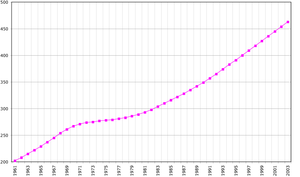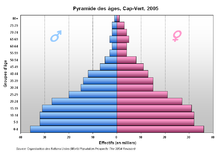- Demographics of Cape Verde
-
This article is about the demographic features of the population of Cape Verde, including population density, ethnicity, education level, health of the populace, economic status, religious affiliations and other aspects of the population.
 Two Cape Verdean children playing marbles.
Two Cape Verdean children playing marbles.
The Cape Verde archipelago was uninhabited when the Portuguese discovered it in 1456. African slaves were brought to the islands to work on Portuguese plantations. As a result, Cape Verdeans are mulattos (mestiços in Portuguese), who have mixed African and European origins. European ancestors also include Spanish and Italian seamen who were granted land by the Portuguese Empire, followed by Portuguese settlers, exiles, and Portuguese Jews who were victims of the Inquisition. Many foreigners from other parts of the world settled Cape Verde as their permanent country. Most of them were Dutch, French, British (English), Arab and Jewish (from Lebanon and Morocco), Chinese (especially from Macau), American, and Brazilian (including people of Portuguese and African descent). All of these have been absorbed into the mestiço population.
Statistics from Portuguese administration in the sixties stated that the racial composition of the inhabitants was 78% of mestiços, 21% of “Africans” (i.e. blacks) and 1% of “Europeans” (i.e. whites). Those figures have been overused in several sites, in spite of not being up to date. Since the independence in 1975 the official statistics in Cape Verde have no longer made statistics based on racial groups. Official sources[1] only states “the majority of the population is mulatto” (“…maioritariamente mestiça…”) without stating any number. Ethnically, Cape Verdeans see themselves as a single group, regardless of being mulatto, black or white.
Survival in a country with few natural resources has historically induced Cape Verdeans to emigrate. In fact, of the more than 1 million people of Cape Verdean ancestry in the world, only a little more than one-third actually live on the islands. Some 500,000 people of Cape Verdean ancestry live in the United States, mainly in New England. Many people of Cape Verdean ancestry also live in Portugal, Netherlands, France, Italy, Argentina, and Senegal. Cape Verdean populations also settled Spain, Germany, Canada, and other CPLP countries (Angola, Brazil and Guinea-Bissau). Since after independence from Portugal in 1975, a number of Cape Verdean students continued to be admitted every year at Portuguese high schools, polytechnical institutes and universities, through bilateral agreements between the Portuguese Government and the Cape Verdean Government.
Although the official language is Portuguese, most Cape Verdeans speak Cape Verdean Creole (Crioulo in Portuguese, Kriolu or Kriol in Cape Verdean Creole). There is a rich repertoire of literature and songs in Creole. In religion, the majority follow Roman Catholic Christianity. There are also some Protestants, Bahá'ís and Muslims.
Demographic statistics
Population
429,474 (July 2010 est.)
CIA World Factbook demographic statistics
The following demographic statistics are from the CIA World Factbook, unless otherwise indicated.
Age structure
- 0-14 years: 37.9% (male 80,594/female 79,126)
- 15-64 years: 55.3% (male 113,450/female 119,423)
- 65 years and over: 6.7% (male 10,542/female 17,844) (2006 est.)
- 0-14 years: 35.2% (male 76,012/female 74,993)
- 15-64 years: 58.5% (male 123,376/female 127,653)
- 65 years and over: 6.4% (male 10,040/female 17,400) (2010 est.)
Median age
- Total: 21.1 years
- Male: 20.4 years
- Female: 20.9 years (2009 est.)
Population growth rate
- 0.561% (2009 est.)
Birth rate
23.5 births/1,000 population (2010 est.)
Death rate
6.22 deaths/1,000 population (2010 est.)
Net migration rate
- -11.67 migrant(s)/1,000 population (2009 est.)
Urbanization
- Urban population: 60% of total population (2008)
- Rate of urbanization: 3.5% annual rate of change (2005-10 est.)
Sex ratio
- At birth: 1.03 male(s)/female
- Under 15 years: 1.01 male(s)/female
- 15-64 years: 0.97 male(s)/female
- 65 years and over: 0.58 male(s)/female
- Total population: 0.95 male(s)/female (2009 est.)
Infant mortality rate
- Total: 41.35 deaths/1,000 live births
- Male: 47.39 deaths/1,000 live births
- Female: 35.12 deaths/1,000 live births (2009 est.)
Life expectancy at birth
- Total population: 71.61 years
- Male: 68.27 years
- Female: 75.05 years (2009 est.)
Total fertility rate
- 2.54 children born/woman (2010 est.)
HIV/AIDS
- Adult prevalence rate: 0.035% (2001 est.)
- People living with HIV/AIDS: 775 (2001)
- Deaths: 225 (as of 2001)
Nationality
- Noun: Cape Verdean(s)
- Adjective: Cape Verdean
Religions
- Roman Catholic (infused with indigenous beliefs); Protestant (mostly Church of the Nazarene), Buddhist 0.2%[citation needed]
Languages
Literacy
- Definition: age 15 and over can read and write
- Total population: 76.6%
- Male: 85.8%
- Female: 69.2% (2003 est.)
Education expenditures
- 6.3% of GDP (2006)
References
 This article incorporates public domain material from the CIA World Factbook document "2008 edition".
This article incorporates public domain material from the CIA World Factbook document "2008 edition".External links
- National Institute of Statistics
- Demographic Highlights — Statistics from the Population Reference Bureau
Currency: Cape Verdean escudo Communications Industries: Trade unions Other DemographicsDemographics of Africa Sovereign
states- Algeria
- Angola
- Benin
- Botswana
- Burkina Faso
- Burundi
- Cameroon
- Cape Verde
- Central African Republic
- Chad
- Comoros
- Democratic Republic of the Congo
- Republic of the Congo
- Côte d'Ivoire (Ivory Coast)
- Djibouti
- Egypt
- Equatorial Guinea
- Eritrea
- Ethiopia
- Gabon
- The Gambia
- Ghana
- Guinea
- Guinea-Bissau
- Kenya
- Lesotho
- Liberia
- Libya
- Madagascar
- Malawi
- Mali
- Mauritania
- Mauritius
- Morocco
- Mozambique
- Namibia
- Niger
- Nigeria
- Rwanda
- São Tomé and Príncipe
- Senegal
- Seychelles
- Sierra Leone
- Somalia
- South Africa
- South Sudan
- Sudan
- Swaziland
- Tanzania
- Togo
- Tunisia
- Uganda
- Zambia
- Zimbabwe
States with limited
recognition- Sahrawi Arab Democratic Republic
- Somaliland
Dependencies and
other territories- Canary Islands / Ceuta / Melilla / Plazas de soberanía (Spain)
- Madeira (Portugal)
- Mayotte / Réunion (France)
- Saint Helena / Ascension Island / Tristan da Cunha (United Kingdom)
- Western Sahara
 Cape Verde topics
Cape Verde topicsPolitics and law Elections · Flag · Emblem · Foreign relations · Military · Law Enforcement · National Assembly · Political parties · President · Prime Minister · LGBT rightsHistory Geography Administrative divisions · Cities · Climate · Extreme points · Islands (Barlavento · Sotavento) · Mountains · Ports · Streams · Villages and settlements · Volcanoes · WildlifeEconomy and infrastructure Culture and society Cape Verdean Creole · Cape Verdean Portuguese · Crime · Demographics · Education · Football · Health · Notable Cape Verdeans · Holidays · Media · Music · Religion · WomenCategories:- Cape Verdean society
- Demographics by country
Wikimedia Foundation. 2010.


